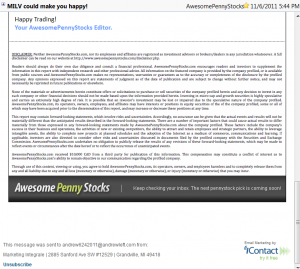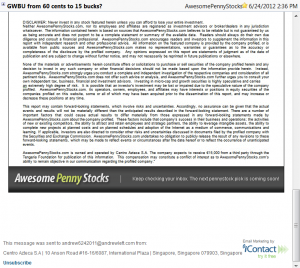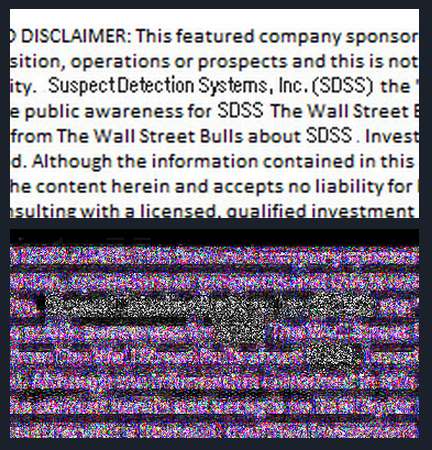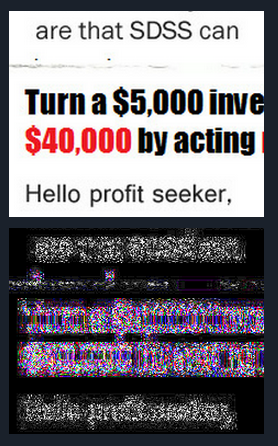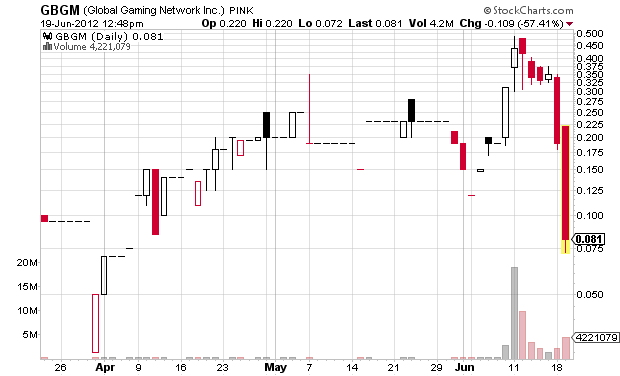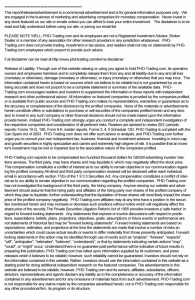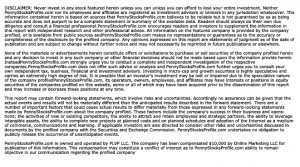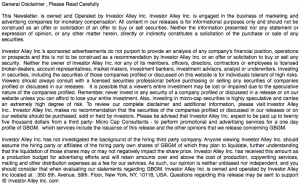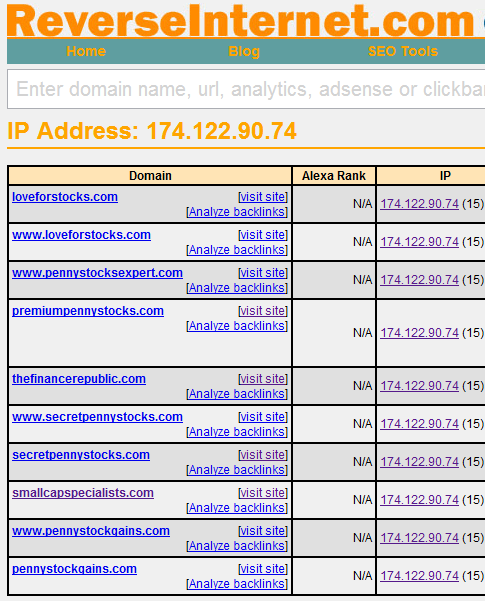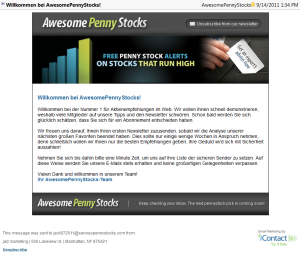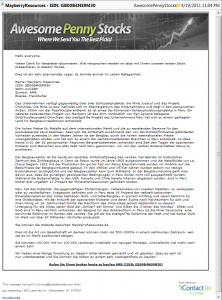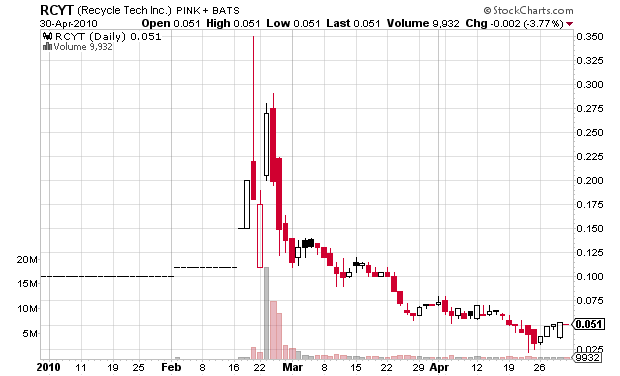Email list theft is not a new thing. Read about a similar lawsuit I previously wrote about. I show some excerpts from the amended complaint below and I provide a few of my own comments. I will post more on this case as it develops.
Initial complaint 3/22/2012 (pdf)
Amended complaint 4/09/2012 (pdf)
Motion to dismiss 6/07/2012 (pdf)
Motion for continuance 6/22/2012 (pdf)
The case is:
MARKETING INTEGRALE CO. v. Todd Roberson, Todd Roberson d/b/a bestdamnstocks.com, thepennystockguru.com a/k/a Jeff Jeffries, William William, Mesa Marketing LLC, otcbullmarkets.com, thebullexchange.com John Does 1-10, ABC Corporation 1-10.
From the amended complaint, we learn the following about the plaintiff:
Plaintiff Marketing Integrale Co. is a web-based Company marketing and customer relations firm, incorporated in Quebec, Canada; principally conducting its business via the internet, and purposefully availing itself to the U.S. Customer base. Integrale maintains core staff in the United States, primarily in Harris County, Houston, Texas and Los Angeles County, Los Angeles, CA.
As you can see from the Awesomepennystocks.com privacy policy page, Marketing Integrale is the corporation behind the website. Screenshot below:
Of course, recent emails from Awesomepennystocks.com have indicated that it is owned by a different legal entity, Centro Azteca S.A.; the most recent email I have on file from Awesomepennystocks.com disclosing in its CANSPAM-required footer that it is Marketing Integrale is from November 6, 2011.
For comparison, here is the most recent email I received from Awesomepennystocks.com. Note that it says it is owned by Centro Azteca S.A.
And the defendants, again from the amended complaint:
Defendant(s)
2. Upon information and belief Todd Roberson, Todd Roberson d/b/a bestdamnstocks.com, thepennystockguru.com aka Jeff Jeffries, William William are the owner(s)/operator(s) of certain web domains that are responsible for Plaintiff’s damages. The address where the defendants may be served with process is at 398 Jade way, Marysville, GA 30558.
3. Upon information and belief Defendant MESA MARKETING LLC, owner of otcmarketbulls.com is responsible for some or all of Plaintiff’s damages. Defendant MESA MARKETING, may be served by providing a copy of this Complaint to counsels, Christine N. Wiseman, Barrister and Solicitor, GILMOUR BARRISTERS, Suite 3 -1 Royce Avenue, BRAMPTON, Ontario L6Y 1J4; or through any other counsel they may so designate, or through their registered agent THE COMPANY CORPORATION, located 2711 CENTERVILLE ROAD SUITE 400, WILMINGTON, DE or wherever they may be found.
4. Upon information and belief Defendant thebullexchange.com is responsible for some or all of Plaintiff’s damages. Plaintiff will serve Defendant thebullexchange.com at its owner(s)’ address where each may be located when said parties are identified.
5. Upon information and belief, John Does 1-10 and ABC Corporation 1-10 are unidentified parties who may be responsible for some or all of the damages incurred by Plaintiff. Plaintiff will serve John Does 1-10 and/or ABC Corporation 1-10 at addresses where each may be located if said parties are identified.
The essence of the legal complaint is that the defendants stole the plaintiff’s email lists. Again from the amended complaint:
13. The Plaintiff charges its customers a dissemination fee (advertising fee) in order for customers to gain access to its email dissemination services to its proprietary database. Upon information and belief, on or around February 18, 2011, the defendants in this case have each/or while in acting in concert by the use of an artifice or scheme, successfully hacked into Marketing Integrale’s server’s hosted at its primarily servers located in the United States at I-contact (http://www.icontact.com). Defendants hacked into Plaintiff’s server in order to gain access, copy, and distribute mail directly to persons on Marketing Integrale’s proprietary e-mail customer lists. By accessing and utilizing Plaintiff’s e-mail list without payment and without authorization, Defendants violated 18 U.S.C. § 2701 and 18 U.S.C. § 1030.
14. Upon information and belief, after the Defendants stole Integrale’s email lists, Defendants incorporated the use of several websites and other associated servers in order to complete their illegal activity.
The allegations in the amended complaint allege the defendants, after having stolen the plaintiff’s email list, then used that email list for their own purposes. Along with various websites, the plaintiffs allege that a couple Twitter accounts and a Facebook account belong to the defendants :
20. Upon information and belief, the websites operated by Defendant Does’ are linked to the Twitter accounts named Sherrybrooks34 and Tracycallies.
21. Upon information and belief, the websites operated by Defendant Does’ are linked to the Facebook account named adria.robinson5.
Mesa Marketing LLC responded by filing a motion to dismiss:
Plaintiff’s pleading leaves open several fundamental questions. What role did defendant Mesa Marketing play in the hacking scheme alleged by the Plaintiff? Who acted on defendant Mesa Marketing’s behalf? How does the website otcmarketbulls.com—allegedly owned by defendant Mesa Marketing—figure into Plaintiff’s claims? The FAC simply does not allege enough facts to infer defendant Mesa Marketing’s misconduct.
Obviously, I am not a lawyer and I cannot evaluate any of the claims by either side.
The most recent filing in the case (on June 22nd) is the plaintiffs’ motion for a continuance, which in this case is a request for more time for the scheduling conference between plaintiff and defendants, for the reason that many of the defendants are unknown to them.
Thanks to Jerry in the Prepromotionstocks chatroom for finding this (he found it somewhere on InvestorsHub, the cesspool of internet stock messageboards).
Disclaimer: No relationship with any parties in the suit. This blog has a terms of use that is incorporated by reference into this post; you can find all my disclaimers and disclosures there as well..

